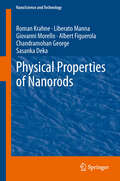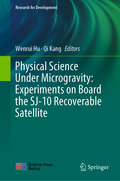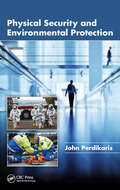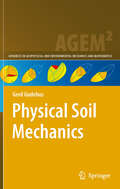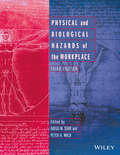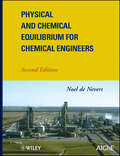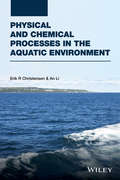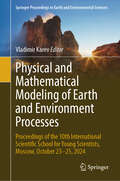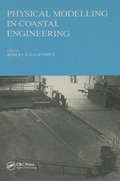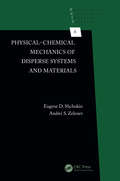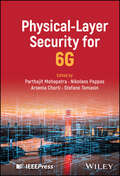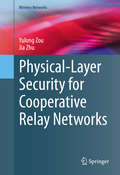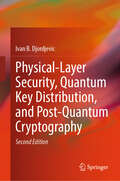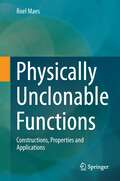- Table View
- List View
Physical Properties of Materials, Third Edition
by Mary Anne WhiteDesigned for advanced undergraduate students and as a useful reference book for materials researchers, Physical Properties of Materials, Third Edition establishes the principles that control the optical, thermal, electronic, magnetic, and mechanical properties of materials. Using an atomic and molecular approach, this introduction to materials science offers readers a wide-ranging survey of the field and a basis to understand future materials. The author incorporates comments on applications of materials science, extensive references to the contemporary and classic literature, and 350 end-of-chapter problems. In addition, unique tutorials allow students to apply the principles to understand applications, such as photocopying, magnetic devices, fiber optics, and more. This fully revised and updated Third Edition includes new materials and processes, such as topological insulators, 3-D printing, and more information on nanomaterials. The new edition also now adds Learning Goals at the end of each chapter and a Glossary with more than 500 entries for quick reference. Web ResourceThe book’s companion website (www.physicalpropertiesofmaterials.com) provides updates to the further reading sections and links to videos made specifically by the author for this book. It also offers sources of demonstration materials for lectures and PowerPoint slides of figures from the book. Many of the features (all those under Student Resources) are freely available to all, including about 30 custom made videos that specifically complement the contents of the book. These videos are highlighted at the appropriate points in the text. The book website also has many links to relevant websites around the world, sorted by chapter, to be used by students, instructors and materials researchers.
Physical Properties of Nanorods
by Albert Figuerola Chandramohan George Giovanni Morello Liberato Manna Roman Krahne Sasanka DekaInorganic nanoparticles are among the most investigated objects nowadays, both in fundamental science and in various technical applications. In this book the physical properties of nanowires formed by nanoparticles with elongated shape, i.e. rod-like or wire-like, are described. The transition in the physical properties is analyzed for nanorods and nanowires consisting of spherical and rod-like nanoparticles. The physical properties of nanowires and elongated inorganic nanoparticles are reviewed too. The optical, electrical, magnetic, mechanical and catalytic properties of nanowires consisting of semiconductors, noble and various other metals, metal oxides properties and metal alloys are presented. The applications of nanorods and nanowires are discussed in the book.
Physical Science Under Microgravity: Experiments on Board the SJ-10 Recoverable Satellite (Research for Development)
by Wenrui Hu Qi KangThis book presents the physical science experiments in a space microgravity environment conducted on board the SJ-10 recoverable satellite, which was launched on April 6th, 2016 and recovered on April 18th, 2016. The experiments described were selected from ~100 proposals from various institutions in China and around the world, and have never previously been conducted in the respective fields. They involve fluid physics and materials science, and primarily investigate the kinetic properties of matter in a space microgravity environment. The book provides a comprehensive review of these experiments, as well as the mission’s execution, data collection, and scientific outcomes.
Physical Science with Earth Science
by Charles William Mclaughlin Marilyn Thompson Ralph FeatherNIMAC-sourced textbook
Physical Science with Earth Science
by Dinah Zike Charles William Mclaughlin Marilyn Thompson Ralph FeatherThe book covers different topics that can be classified under the two main categories Earth science ( that investigates Earth and space) and Physical science (that studies matter and energy.)
Physical Science: Concepts in Action
by Michael Wysession David Frank Sophia YancopoulosNIMAC-sourced textbook
Physical Science: Concepts in Action, With Earth and Space Science
by Michael Wysession Sophia Yancopoulos David V. FrankPhysical Science is the study of non-living systems, as opposed to a study of biological sciences or living systems. It consists of physics, chemistry, astronomy and earth science. It also includes scientific method and experimentation and this is what this textbook is all about.
Physical Security and Environmental Protection
by John PerdikarisManage a Hazard or Threat Effectively and Prevent It from Becoming a DisasterWhen disaster strikes, it can present challenges to those caught off guard, leaving them to cope with the fallout. Adopting a risk management approach to addressing threats, vulnerability, and risk assessments is critical to those on the frontline. Developed with first res
Physical Security and Safety: A Field Guide for the Practitioner (Occupational Safety & Health Guide Series #17)
by Truett A. Ricks Bobby E. Ricks Jeff DingleHow-To Guide Written By Practicing ProfessionalsPhysical Security and Safety: A Field Guide for the Practitioner introduces the basic principles of safety in the workplace, and effectively addresses the needs of the responsible security practitioner. This book provides essential knowledge on the procedures and processes needed for loss reduction, p
Physical Soil Mechanics
by Gerd GudehusSoil is matter in its own right. Its nature can be captured by means of monotonous, cyclic and strange attractors. Thus material properties are defined by the asymptotic response of sand- and clay-like samples to imposed deformations and stresses. This serves to validate and calibrate elastoplastic and hypoplastic relations with comparative plots. Extensions capture thermal and seismic activations, limitations occur due to localizations and skeleton decay.Attractors in the large characterize boundary value problems from model tests via geotechnical operations up to tectonic evolutions. Validations of hypoplastic calculations are shown with many examples, possible further applications are indicated in detail. This approach is energetically justified and limited by critical points where the otherwise legitimate continuity gets lost by localization and decay. You will be fascinated by the fourth element although or just as it is so manifold.
Physical and Biological Hazards of the Workplace
by Gregg M. Stave Peter H. WaldCompletely updated version this classic reference covers both physical hazards and biological agents Provides updated information on protecting workers from proven and possible health risks from manual material handling, extremes of temperature and pressure, ionizing and non-ionizing (magnetic fields) radiation, shiftwork, and more Details major changes in our understanding of biological hazards including Ebola, Chikungunya, Zika, HIV, Hepatitis C, Lyme disease, MERS-CoV, TB, and much more All infectious diseases have been updated from an occupational health perspective Includes practical guidance on to how to set up medical surveillance for hazards and suggests preventive measures that can be used to reduce occupational diseases
Physical and Chemical Dissolution Front Instability in Porous Media
by Chongbin ZhaoThis monograph provides state-of-the-art theoretical and computational findings from investigations on physical and chemical dissolution front instability problems in porous media, based on the author's own work. Although numerical results are provided to complement theoretical ones, the focus of this monograph is on the theoretical aspects of the topic and those presented in this book are applicable to a wide range of scientific and engineering problems involving the instability of nonlinear dynamic systems. To appeal to a wider readership, common mathematical notations are used to derive the theoretical solutions. The book can be used either as a useful textbook for postgraduate students or as a valuable reference book for computational scientists, mathematicians, engineers and geoscientists.
Physical and Chemical Equilibrium for Chemical Engineers
by Noel De NeversThis book concentrates on the topic of physical and chemical equilibrium. Using the simplest mathematics along with numerous numerical examples it accurately and rigorously covers physical and chemical equilibrium in depth and detail. It continues to cover the topics found in the first edition however numerous updates have been made including: Changes in naming and notation (the first edition used the traditional names for the Gibbs Free Energy and for Partial Molal Properties, this edition uses the more popular Gibbs Energy and Partial Molar Properties,) changes in symbols (the first edition used the Lewis-Randal fugacity rule and the popular symbol for the same quantity, this edition only uses the popular notation,) and new problems have been added to the text. Finally the second edition includes an appendix about the Bridgman table and its use.
Physical and Chemical Processes in the Aquatic Environment
by An Li Erik R. Christensend transformation. The book also includes the most up to date information including a discussion on emerging pollutants such as brominated and phosphate flame retardants, perflurochemicals, and pharmaceutical and personal care products. Due to its importance an ecotoxicology chapter has been included featuring molecular biological methods, nanoparticles, and comparison of the basis of biotic ligand model with the Weibull dose-response model. Finally, the last chapter briefly summarizes the regulations on ambient water quality.
Physical and Data-Link Security Techniques for Future Communication Systems
by Marco Baldi Stefano TomasinThis book focuses on techniques that can be applied at the physical and data-link layers of communication systems in order to secure transmissions against eavesdroppers. Topics ranging from information theory-based security to coding for security and cryptography are discussed, with presentation of cutting-edge research and innovative results from leading researchers. The characteristic feature of all the contributions is their relevance for practical embodiments: detailed consideration is given to applications of security principles to a variety of widely used communication techniques such as multiantenna systems, ultra-wide band communication systems, power line communications, and quantum key distribution techniques. A further distinctive aspect is the attention paid to both unconditional and computational security techniques, providing a bridge between two usually distinct worlds. The book comprises extended versions of contributions delivered at the Workshop on Communication Security, held in Ancona, Italy, in September 2014 within the framework of the research project "Enhancing Communication Security by Cross-layer Physical and Data-link Techniques", funded by the Italian Ministry of Education, Universities, and Research.
Physical and Mathematical Modeling of Earth and Environment Processes: Proceedings of the 10th International Scientific School for Young Scientists, Moscow, October 18–20, 2024 (Springer Proceedings in Earth and Environmental Sciences)
by Vladimir KarevThe book presents short papers of participants of the 10th International Scientific Conference and School for Young Scientists «Physical and Mathematical Modeling of Earth and Environment Processes. The book includes theoretical and experimental studies of processes in the atmosphere, oceans, the lithosphere and their interaction; environmental issues; problems of human impact on the environment; methods of geophysical research. Research of the dynamic of natural systems - geosphere, hydrosphere, atmosphere and their interactions, the human contribution to naturally occurring processes are among the most urgent and practically important scientific problems. Intensive development of research in these areas is due to several factors. The widespread introduction of computer technology has allowed beginning calculation of complex phenomena, previously unavailable for analysis. Creation and improvement of a new generation of geophysical instruments, remote observing systems based on the ship, aircraft, and satellite allowed us to obtain a large amount of data to objectively reflect the picture of the processes. The articles included in these book reflect also an important role of the laboratory modeling in searching of processes in geo-environments and testing of new developed physical and mathematical models. Development of measurement, optic information and other techniques provide new opportunities to perform controllable and reproducible laboratory data for generations of new ideas and concepts. Systematic stream of high resolution laboratory data stimulates development of analytical and numerical models of the dynamical processes in three nature environments. A special focus is given to the extraction of hydrocarbon resources, including from unconventional sources. An alternative to the use of hydrocarbons as a main source of energy on the Planet in the coming decades is unlikely to be found. At the same time, the resource base of hydrocarbons is quickly depleted, in particularly, large and accessible oil and gas fields. The shale oil and gas, Arctic hydrocarbon stocks, gas hydrates, coal bed methane, oil and gas from deep horizons can become new sources.
Physical and Statistical Models for Steam Generator Clogging Diagnosis
by Sylvain GirardClogging of steam generators in nuclear power plants is a highly sensitive issue in terms of performance and safety and this book proposes a completely novel methodology for diagnosing this phenomenon. It demonstrates real-life industrial applications of this approach to French steam generators and applies the approach to operational data gathered from French nuclear power plants. The book presents a detailed review of in situ diagnosis techniques and assesses existing methodologies for clogging diagnosis, whilst examining their limitations. It also addresses numerical modelling of the dynamic behaviour of steam generators and provides a thorough analysis of statistical methods for sensitivity analysis and dimension reduction. Steam generators are heat exchangers found in nuclear power plants and over time they become increasingly clogged by iron oxides. This clogging then hampers the flow inside steam generators and compromises their mechanical integrity, which hinders performance and safety. This book is intended for nuclear safety specialists, nuclear performance engineers and researchers and postgraduate students working on heat exchanger modeling and computational engineering.
Physical modelling in coastal engineering: Proceedings of an international conference, Newark, Delaware, August 1981
by Robert A. DalrympleCoastal engineering is a field which has grown in importance over the last forty years as mankind has utilised and become dependent on the coastlines of the world to a greater extent. The activities in the field include the study of wave dynamics, shoreline erosion and protection, harbor and breakwater design, dredging technology, estuary mechanics and storm surge calculations, as well as offshore structural design. In all of these areas the level of actvity is high and the state of art has imporved dramatically since the 1940's. An important aspect of all these areas of research is the use of model studies. This volume consists of a number of papers which cover various aspects of physical modelling in coastal engineering, including the generation of waves in the laboratory, the modelling of sediment transport and the application to various engineering problems. The intent is to provide the reader with an overview of the research actvities of indviduals who represent major laboratories in their countries: to include Denmark, Scotland, Canada, the People's Republic of China, England, the Netherlands and the U.S.
Physical-Chemical Mechanics of Disperse Systems and Materials (Progress in Colloid and Interface Science)
by Eugene D. Shchukin Andrei S. ZelenevPhysical-Chemical Mechanics of Disperse Systems and Materials is a novel interdisciplinary area in the science of the disperse state of matter. It covers the broad spectrum of objects and systems with dimensions ranging from nanometers to millimeters and establishes a fundamental basis for controlling and tuning the properties of these systems as w
Physical-Chemical Treatment of Water and Wastewater
by Arcadio P. Sincero Gregoria A. SinceroThe books currently available on this subject contain some elements of physical-chemical treatment of water and wastewater but fall short of giving comprehensive and authoritative coverage. They contain some equations that are not substantiated, offering empirical data based on assumptions that are therefore difficult to comprehend. This text bring
Physical-Layer Security and Quantum Key Distribution
by Ivan B. DjordjevicThis textbook integrates the most advanced topics of physical-layer security, cryptography, covert/stealth communications, quantum key distribution (QKD), and cyber security to tackle complex security issues. After introducing the reader to various concepts and practices, the author addresses how these can work together to target problems, rather than treating them as separate disciplines. This book offers students an in-depth exposition on: cryptography, information-theoretic approach to cryptography, physical-layer security, covert/stealth/low-probability of detection communications, quantum information theory, QKD, and cyber security; to mention few. The goal is to provide a unified description of the most advanced topics related to: (i) modern cryptography, (ii) physical-layer security, (iii) QKD, (iv) covert communications, and (v) cyber security. Each chapter is followed by a set of problems. Also, for readers to better understand the book, an appendix covers all needed background. Homework problems and lecture notes are available online. The book does not require any prior knowledge or prerequisite material.
Physical-Layer Security for 6G
by Stefano Tomasin Nikolaos Pappas Parthajit Mohapatra Arsenia ChortiMeet the wireless security challenges of the future with this key volume The 6th generation of wireless communication technology—known as 6G—promises to bring both revolutionary advances and unique challenges. Secure communications will be harder than ever to achieve under the new integrated ground, air, and space networking paradigm, with increased connectivity creating the potential for increased vulnerability. Physical-layer security, which draws upon the physical properties of the channel or network to secure information, has emerged as a promising solution to these challenges. Physical-Layer Security for 6G provides a working introduction to these technologies and their burgeoning wireless applications. With particular attention to heterogeneous and distributed network scenarios, this book offers both the information-theory fundamentals and the most recent developments in physical-layer security. It constitutes an essential resource for meeting the unique security challenges of 6G. Physical-Layer Security for 6G readers will also find: Analysis of physical-layer security in the quality of security framework (QoSec)Detailed discussion of physical-layer security applications in visible light communication (VLC), intelligence reflecting surface (IRS), and morePractical use cases and demonstrations Physical-Layer Security for 6G is ideal for wireless research engineers as well as advanced graduate students in wireless technology.
Physical-Layer Security for Cooperative Relay Networks
by Yulong Zou Jia ZhuThis book presents physical-layer security as a promising paradigm for achieving the information-theoretic secrecy required for wireless networks. It explains how wireless networks are extremely vulnerable to eavesdropping attacks and discusses a range of security techniques including information-theoretic security, artificial noise aided security, security-oriented beamforming, and diversity assisted security approaches. It also provides an overview of the cooperative relaying methods for wireless networks such as orthogonal relaying, non-orthogonal relaying, and relay selection. Chapters explore the relay-selection designs for improving wireless secrecy against eavesdropping in time-varying fading environments and a joint relay and jammer selection for wireless physical-layer security, where a relay is used to assist the transmission from the source to destination and a friendly jammer is employed to transmit an artificial noise for confusing the eavesdropper. Additionally, the security-reliability tradeoff (SRT) is mathematically characterized for wireless communications and two main relay-selection schemes, the single-relay and multi-relay selection, are devised for the wireless SRT improvement. In the single-relay selection, only the single best relay is chosen for assisting the wireless transmission, while the multi-relay selection invokes multiple relays for simultaneously forwarding the source transmission to the destination. Physical-Layer Security for Cooperative Relay Networks is designed for researchers and professionals working with networking or wireless security. Advanced-level students interested in networks, wireless, or privacy will also find this book a useful resource.
Physical-Layer Security, Quantum Key Distribution, and Post-Quantum Cryptography
by Ivan B. DjordjevicThis book introduces the reader to the most advanced topics of physical-layer security (PLS), cryptography, covert/stealth communications, and quantum key distribution (QKD), also known as the quantum cryptography, and post-quantum cryptography (PQC). So far, these topics have been considered as separate disciplines, even though they are targeting the same security problems we are facing today. The book integrates modern cryptography, physical-layer security, QKD, covert communication, PQC, and cyber security technologies. The book is intended for a very diverse group of readers in communications engineering, optical engineering, wireless communications, free-space optical communications, optical wireless communications, mathematics, physics, communication theory, information theory, photonics, as well as computer science.
Physically Unclonable Functions
by Roel MaesPhysically unclonable functions (PUFs) are innovative physical security primitives that produce unclonable and inherent instance-specific measurements of physical objects; in many ways they are the inanimate equivalent of biometrics for human beings. Since they are able to securely generate and store secrets, they allow us to bootstrap the physical implementation of an information security system. In this book the author discusses PUFs in all their facets: the multitude of their physical constructions, the algorithmic and physical properties which describe them, and the techniques required to deploy them in security applications. The author first presents an extensive overview and classification of PUF constructions, with a focus on so-called intrinsic PUFs. He identifies subclasses, implementation properties, and design techniques used to amplify submicroscopic physical distinctions into observable digital response vectors. He lists the useful qualities attributed to PUFs and captures them in descriptive definitions, identifying the truly PUF-defining properties in the process, and he also presents the details of a formal framework for deploying PUFs and similar physical primitives in cryptographic reductions. The author then describes a silicon test platform carrying different intrinsic PUF structures which was used to objectively compare their reliability, uniqueness, and unpredictability based on experimental data. In the final chapters, the author explains techniques for PUF-based entity identification, entity authentication, and secure key generation. He proposes practical schemes that implement these techniques, and derives and calculates measures for assessing different PUF constructions in these applications based on the quality of their response statistics. Finally, he presents a fully functional prototype implementation of a PUF-based cryptographic key generator, demonstrating the full benefit of using PUFs and the efficiency of the processing techniques described. This is a suitable introduction and reference for security researchers and engineers, and graduate students in information security and cryptography.

